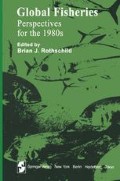Abstract
The typical system of present-day fishery management is generally thought of as consisting of several stages. First, data are collected from fish markets and research vessels; second, these are analyzed at biological research institutions where the effects of alternative management measures are predicted; third, on the basis of these predictions, and in the light of social and economic objectives, one particular management measure is chosen; and finally, appropriate legal measures are introduced and duly enforced.
John A. Gulland’s early training was as a mathematician. He worked for a number of years at the Fisheries Laboratory, Lowestoft, England, where he specialized on the population dynamics of demersal fish. He has been concerned with providing scientific advice to various international commissions, such as the Northeast Atlantic Fisheries Commission, the International Commission for the Northwest Atlantic Fisheries, and the International Whaling Commission. Since 1966 he has been with the Department of Fisheries, Food and Agriculture Organization of the United Nations, Rome, concerned with fisheries management and planning of fisheries development programs throughout the world.
Access this chapter
Tax calculation will be finalised at checkout
Purchases are for personal use only
Preview
Unable to display preview. Download preview PDF.
References
Andersen, K. P., and E. Ursin. 1977. A multispecies extension to the Beverton and Holt theory of fishing, with accounts of phosphorus circulation and primary production. Meddr. Dan. m. Fiskeri-og-Havunders N.S. 7:319–436.
Clark, C. W. 1976. Mathematical Bioeconomics: The Optimal Management of Renewable Resources. John Wiley, New York, 352 pp.
Doubleday, W. G. 1976. Environmental fluctuations and fisheries management. Collected Papers. Int. Common. Northw. Atl. Fish. 1:141–150.
FAO. 1978. Some Scientific Problems of Multispecies Fisheries. Report of the Expert Consultation on Management of Multispecies Fisheries, Rome, Italy, 20–23 September 1977. FAO Fish. Tech. Pap. 181, p. 42.
FAO. 1980. ACMRR Working Party on the Scientific Basis of Determining Management Measures. Report of the ACMRR Working Party on the scientific basis of determining management measures. Hong Kong, 10–15 December 1979. FAO Fish. Rep. 236, p. 149.
FAO. 1981. Report of an expert consultation on monitoring, control and surveillance systems for fishery management. (Mimeo.)
Glantz, M. H., and J. D. Thompson (eds.). 1981. Resource Management and Environmental Uncertainty: Lessons from Up welling Fisheries. New York, Wiley Interscience. 491 pp.
Graham, M. 1939. The sigmoid curve and the overfishing problem. Rapp. Proc-Verb. Cons. Int. Explor. Mer 110(2): 15–20.
Gulland, J. A. 1965. Estimation of mortality rates. Annex to Arctic Fisheries Working Group Report. Int. Cons. Expl. Sea, Ann. Meeting, 1965. (Mimeo.)
Gulland, J. A. 1981. Long-term potential effects from management of the fish resources of the North Atlantic. J. Cons. Int. Expl. Mer. 40(1):8–16.
Holling, C. S. (ed). 1978. Adaptive environmental assessment and management. Wiley, Int. Inst. Applied Systems Analysis, Chichester, U.K., 377 pp.
Holt, S. J., and L. M. Talbot. 1978. New principles for the conservation of wild living resources. Wildlife Monogr. 59:1–33.
IMARPE. 1970a. Report of the panel of experts on population dynamics of Peruvian anchoveta. Bol. Inst, del Mar del Peru 2(6). 324–371.
IMARPE. 1970b. Report of panel of experts on the economic effects of alternaive regulatory measures in the Peruvian anchoveta fishery. Inf. Inst. Mar Peru, Callao 34, p. 83.
IMARPE. 1972. Report of the second session of the panel of experts on the population dynamics of Peruvian anchoveta. Bol. Inst, del Mar del Peru 2(7) 377–457.
IMARPE. 1973. Report of the third session of the panel of experts on the population dynamics of Peruvian anchoveta. Bol. Inst, del Mar del Peru 2(9). 525–599.
Jones, R. 1964. Estimating population size from commercial statistics when fishing mortality varies with age. Rapp. Proc.-Verb. Int. Cons. Expl. Mer, 155: 210–214.
Laevastu, T., and H. A. Larkins. 1981. Marine Fisheries Ecosystem: Its Quantitative Evaluation and Management. Fishing News Books Ltd., London, U.K.
Larkin, P. A. 1972. A confidential memorandum on fisheries science. In: B. J. Rothschild (Ed.), World Fisheries Policy. Univ. of Washington Press, Seattle.
May, R. M., J. R. Beddington, J. W. Howard, and J. G. Shepherd. 1978. Exploiting natural populations in an uncertain world. Math. Biosci. 42:219–252.
May, R. M., J. R. Beddington, C. W. Clark, S. J. Holt, and R. M. Laws. 1979. Management of multispecies fisheries. Science 205(4403): 267–277.
Murphy, G. I. 1965. A solution of the catch equation. J. Fish. Res. Bd. Can. 22(l):191–202.
Paulik, G. J. 1971. Anchovies, birds and fishermen in the Peru Current. In: W. W. Murdoch (Ed.), Environment: Resources, Pollution and Society. Sinauer, Stanford, Conn.
Schaefer, M. B. 1954. Some aspects of the dynamics of populations important to the management of marine fisheries. Bull. Inter-American Tropical Tuna Comm. 1:25–56.
Scott, A. D. 1955. The fishery: the objectives of sole ownership. J. Polit. Econ. 63:116–124.
Walters, C. J. 1981. Optimum escapements in the face of alternative recruitment hypotheses. Can. J. Fish. Aquat. Sci. 38:678–689.
Walters, C. J., and R. Hilborn. 1976. Adaptive control of fishery systems. J. Fish. Res. Bd. Can. 33:145–159.
Editor information
Editors and Affiliations
Rights and permissions
Copyright information
© 1983 Springer-Verlag New York Inc.
About this chapter
Cite this chapter
Gulland, J.A. (1983). Managing Fisheries in an Imperfect World. In: Rothschild, B.J. (eds) Global Fisheries. Springer Series on Environmental Management. Springer, New York, NY. https://doi.org/10.1007/978-1-4612-5467-6_8
Download citation
DOI: https://doi.org/10.1007/978-1-4612-5467-6_8
Publisher Name: Springer, New York, NY
Print ISBN: 978-1-4612-5469-0
Online ISBN: 978-1-4612-5467-6
eBook Packages: Springer Book Archive

